The term ‘heartburn’ is misleading as it has nothing to do with the heart. However, because the burning sensation often occurs in the chest and can mimic the symptoms of a heart attack, the condition earned its name.
When there is a reflux of acids from the stomach into the oesophagus (the tube that joins the throat and the stomach), the resulting sensation is known as heartburn. The pain starts from under the breastbone or in the chest and may often even reach the jaw. It usually gets worse during the evenings, when bending over or lying down. Apart from the pain, other symptoms include a bitter taste in the mouth that may feel acidic and foul1,2.
There could be many reasons why heartburn occurs. Sometimes, heartburn occurs because the lower oesophageal sphincter (LES), a muscular valve between the oesophagus and the stomach, doesn’t function properly.
In normal cases, it opens up to let in food or to let out burps. Sometimes, it may open more frequently than necessary or not close properly, allowing the stomach acids to flow into the oesophagus. These acids cause the burning sensation that we associate with heartburn3. The common causes of heartburn is as follows4,5:
Symptoms of heartburn include:
Heartburn could last from a few minutes to several hours, depending on the person’s body chemistry. It is very common in pregnant women.
When heartburn happens occasionally, it is nothing to worry about. Most individuals who have heartburn can improve the situation with lifestyle changes and through over-the-counter medications. But when it is a recurring problem, it may interfere with your day-to-day functioning and could be a cause of worry. Recurrent heartburn is known as Gastroesophageal Reflux Disease (GERD). This can lead to more problems like5:
Heartburn is sometimes known to worsen asthma in asthmatic patients, if you experience this condition, it is advisable to consult your Pulmonologist or a Physician
Dr. Ashish Bajaj, M.B.B.S., M.D. in Clinical Pharmacology and Toxicology
GERD and heartburn are more connected than you may think. If you experience frequent episodes of heartburn, you may have Gastroesophageal Reflux Disease (GERD). In that case, you may benefit by using heartburn home remedies to help with the uneasiness. Sometimes it can happen that heartburn is not a prominent symptom, but the sustained cough is. To test for GERD, the upper endoscopy is used for a complete understanding of the symptoms.
Other tests which can be used to detect the disease include the 24-hour pH test (assesses oesophageal pH), MII-pH test (to detect non-acid reflux), and proton pump inhibitors (PPIs) trial. In the PPIs trial test, the doctor will give you medication that is given to patients who have the disease. If your symptoms start to subside, then it would mean you have GERD4.
Another common test that no longer is recommended by physicians is the Barium swallow5.
Seek an appointment with your doctor if:
The following tips can be considered with the guidance of a doctor to help manage heartburn3:
It is rare that there might be a situation where your stomach pushes up through your diaphragm, causing a condition called hiatal hernia. This condition may present with symptoms mimicking heartburn. Ensure to follow-up with a Gastroenterologist if you have persisting heartburn.
Dr. Ashish Bajaj, M.B.B.S., M.D. in Clinical Pharmacology and Toxicology
Individuals who have heartburn but have no other serious complications with it, may find it beneficial to consider the following lifestyle changes:
Also Read: The Best Home Remedies For Hernia
Heartburn can be caused by many factors. Consult a doctor to find the underlying cause of your heartburn in order to begin treatment. Although lifestyle changes usually bring relief in most cases, it is important to seek a doctor’s advice immediately if you don’t see any benefit3.
Disclaimer: The information provided here is for educational/awareness purposes only and is not intended to be a substitute for medical treatment by a healthcare professional and should not be relied upon to diagnose or treat any medical condition. The reader should consult a registered medical practitioner to determine the appropriateness of the information and before consuming any medication. PharmEasy does not provide any guarantee or warranty (express or implied) regarding the accuracy, adequacy, completeness, legality, reliability or usefulness of the information; and disclaims any liability arising thereof.
Anaemia is a medical condition in which the body has a reduced number of red blood cells or a lower-than-normal concentration of haemoglobin. Haemoglobin is the oxygen-carrying protein in red blood cells, responsible for delivering oxygen from the lungs to various tissues and organs. When haemoglobin levels are low, the oxygen supply to the body’s organs becomes inadequate, leading to symptoms such as fatigue, weakness, and shortness of breath1.
While conventional treatments for anaemia are effective and often necessary, several natural and home-based remedies can support recovery and improve overall haemoglobin levels. If you’re interested in exploring safe and holistic options for managing anaemia, the following home remedies may be helpful.

Beetroot is often recommended as a supportive food for individuals with anaemia due to its iron and folate content, which are essential for red blood cell production. Regular consumption may help improve haemoglobin levels, thereby supporting better oxygen transport in the body2.
Beetroot can be consumed in various forms, raw as part of a salad, steamed or cooked as a vegetable, or blended into juice. Drinking beetroot juice on an empty stomach is a popular method for maximising nutrient absorption.
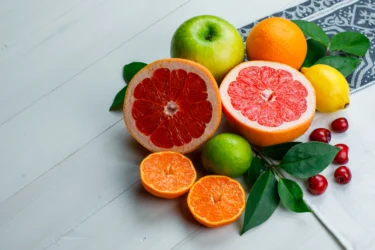
Regular intake of vitamin C has been shown to improve iron absorption in individuals with iron-deficiency anaemia. Vitamin C enhances the intestinal absorption of non-haeme iron (plant-based iron), thereby supporting improved haemoglobin production3.
Include natural sources of vitamin C in your daily diet, such as oranges, lemons, sweet limes, amla (Indian gooseberry), and guavas. Consuming these fruits regularly can aid in better iron absorption and support recovery from anaemia4.
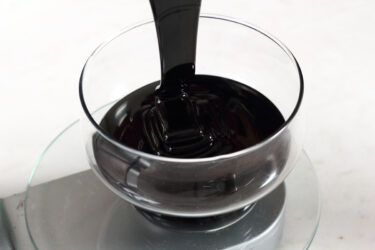
Blackstrap molasses is a rich natural source of iron, along with B vitamins and essential minerals like magnesium and calcium. Regular consumption can support the production of red blood cells and improve haemoglobin levels, making it beneficial for individuals with iron-deficiency anaemia5. One way to consume blackstrap molasses is by mixing a teaspoon into a cup of warm water or plant-based milk. This can be taken once daily, preferably on an empty stomach, to enhance iron absorption.
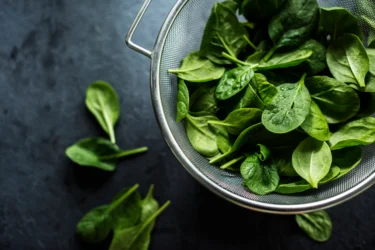
Anaemia can result from various nutritional deficiencies, including folic acid, which is essential for the production of healthy red blood cells. A deficiency in folic acid can lead to megaloblastic anaemia, characterised by large, immature red blood cells that cannot function properly. Including spinach in your regular diet can help manage folic acid deficiency, as it is a rich source of folate along with iron, vitamin A, and vitamin C. While spinach does not contain vitamin B12, it still supports overall blood health and should be consumed regularly in cooked or lightly sautéed forms to enhance nutrient absorption.
Severe iron deficiency anaemia may increase your risk of developing complications that affect the heart or lungs, such as an abnormally fast heartbeat (tachycardia) or heart failure. It is pertinent to get treated for anaemia as soon as you experience any symptoms of anaemia.
Dr Ashish Bajaj, M.B.B.S, M.D. in Clinical Pharmacology and Toxicology

Bananas are a nutritious fruit containing moderate amounts of vitamin C, folate, and potassium, which contribute to overall health and support the body’s metabolic functions. While they contain only a small amount of iron, the vitamin C present may aid in enhancing iron absorption from other dietary sources. Therefore, bananas can be included as a supportive food in a balanced diet aimed at improving haemoglobin levels, but they should not be considered a primary treatment for iron-deficiency anaemia7.

Raisins and dates are natural sources of dietary iron and provide some fibre and energy. Although they contain only trace amounts of vitamin C, pairing them with fruits rich in vitamin C, such as oranges or amla can help improve iron absorption8,9. Including soaked dates, raisins, and figs a few times a week as part of a balanced diet may help support haemoglobin levels over time, especially when combined with other iron-rich and vitamin C-rich foods10.
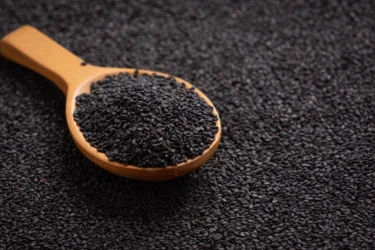
Black sesame seeds are a good plant-based source of iron, along with calcium and magnesium. While they do not directly enhance iron absorption, their inclusion in the diet can support iron intake, especially for individuals following a vegetarian diet. Soaking a teaspoon of black sesame seeds overnight and consuming them the next morning, either chewed or as a paste may help improve mineral availability slightly. For best results, pair with foods rich in vitamin C to enhance iron absorption11.
Many natural remedies that can help support anaemia management are found right in your kitchen. Choosing the right foods and herbs can complement your treatment and improve your overall health.
Certain plants and foods in nature can help improve symptoms of anaemia. For example, tulsi (holy basil) contains antioxidants and vitamin C, which aids iron absorption. Beetroot is rich in folic acid, an important nutrient for red blood cell formation. Fruits like pomegranates and apples provide a good source of iron. Including foods rich in vitamin C, such as citrus fruits, alongside iron-rich foods can enhance the body’s ability to absorb iron effectively.
Dr. M.G. Kartheeka, MBBS, MD (Paediatrics)
It is important to create a balanced diet plan to support its management. Before focusing on specific foods, keep the following points in mind when planning your diet:
Now, here are some of the common foods you can consume to treat anaemia:
Also Read: Home Remedies for Jaundice By Dr. Siddharth Gupta
Anaemia can be managed effectively by combining medical treatment with a balanced diet rich in iron and supporting nutrients. Including natural remedies and vitamin C-rich foods helps improve iron absorption and overall health. Always seek professional advice alongside these home-based approaches for best results.
Disclaimer: The information provided here is for educational/awareness purposes only and is not intended to be a substitute for medical treatment by a healthcare professional and should not be relied upon to diagnose or treat any medical condition. The reader should consult a registered medical practitioner to determine the appropriateness of the information and before consuming any medication. PharmEasy does not provide any guarantee or warranty (express or implied) regarding the accuracy, adequacy, completeness, legality, reliability or usefulness of the information; and disclaims any liability arising thereof.
Garlic is a spice that is used in the kitchen for centuries. This herb is known to have curative and medicinal properties because of its antibacterial and antiseptic nature. These beneficial properties of garlic are because of a compound, allicin. Garlic is also rich in minerals like phosphorus, zinc, potassium, and magnesium. Vitamin C, vitamin K, folate, niacin and thiamine also are found abundantly in garlic1,2.
Here is the nutritional chart for 100 grams of raw garlic. Note that 1 medium to large garlic clove weighs between 3-8 grams each. The RDI- Percentage of recommended daily intake of garlic is as follows5:
Vitamins
Minerals

Raw garlic has the potential to reduce cough and cold in children and adults3. Research4 suggests that using garlic may help relieve symptoms of congestion in children.

Allicin, a compound found in garlic stops the oxidizing of LDL (bad cholesterol). This reduces cholesterol levels and improves heart health. Regular consumption of garlic reduces the incidence of blood clots and thus helps prevent thromboembolism . Garlic also lowers blood pressure so is good for patients with hypertension1,3,6.

Several studies7 suggest that garlic may be beneficial for brain health because of its antioxidant and anti-inflammatory properties It may be effective in neurodegenerative diseases like Alzheimer’s and dementia6.

Digestive problems improve with the inclusion of raw garlic in the diet. It has shown beneficial effects on the intestines and also reduces inflammation. Eating raw garlic helps to clear out intestinal worms. The advantage of garlic is it promotes the growth of good bacteria and reduces the bad bacteria thus helping in better digestive health6.

Research1 suggests that those who have diabetes may observe their blood sugar levels improve by eating raw garlic, but always consult a doctor to know if this can be beneficial to your case before making changes to your diet.

Garlic may help reduce free radicals and damage to the DNA. The zinc in garlic may promote immunity and the vitamin C may help with infections. Garlic may also be beneficial in eye and ear infections because of their antimicrobial properties1,2.

Garlic helps prevent acne and lightens acne scars. Cold sores, psoriasis, rashes, and blisters may benefit from the application of garlic juice. It may also protect against UV rays and therefore may benefit from ageing8. Garlic may cause skin irritation and chemical burns so use it only under the guidance of a doctor.
Based on my observations, garlic has been potentially used in traditional medicine for ages. It’s pretty fascinating how it can be helpful in different things. For instance, studies2 have shown that garlic may be effective in dealing with warts, denture stomatitis, venous ulcers, and even skin wounds. So, if you’re dealing with any of these issues, using garlic might just do the trick.
Dr. Smita Barode, B.A.M.S, M.S.

Research1 suggests that because of the high amount of antioxidants, garlic may help protect the body against lung, prostate, bladder, stomach, liver and colon cancer. The antibacterial property of garlic helps prevent peptic ulcers as it helps remove the pathogen from the gut2,6.

Garlic reduces the expression of genes responsible for the formation of adipose cells which store fat. It also increases thermogenesis in the body and leads to the burning of more fat and the lowering of LDL (bad cholesterol)2.
Apart from the fact that it is good for weight loss, garlic is highly nutritional. In fact, one clove of raw garlic, which is around 3 grams, contains2,3:

Garlic is considered one of the best ”performance enhancing” substances. In olden times, garlic was used to treat fatigue and improve the work capacity of labourers. Studies on rodents suggest consuming garlic helps in improving exercise performance. People who had heart disease consumed garlic for 6 weeks and this resulted in a 12% reduction in their heart rate and better exercise capacity9.

Fresh garlic juice has the potential to reduce the growth of E. coli bacteria that cause urinary tract infection (UTI). It also helps prevent kidney infections.
Garlic reduces infections on wounds, promotes hair growth, bone health and liver health2. Most of the home remedies are effective only if garlic is consumed raw but should be done only with the supervision of a healthcare provider.

According to studies11 from Japan, raw garlic when aged in a mixture of water and alcohol may have significant effects on exercise endurance. Human studies have also been conducted that have shown that garlic can indeed improve the symptoms of exercise fatigue.
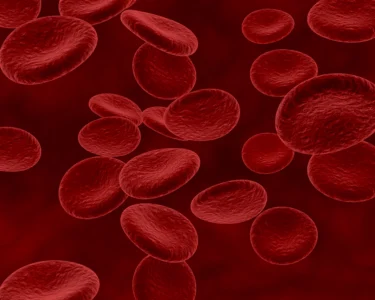
For people who are susceptible to lead poisoning due to occupational hazards, garlic may be the best organic solution. Research suggests that garlic is safer and better at reducing lead poisoning of the blood than d-Penicillamine, which is the common drug used to treat the same10.
Also Read: Natural Blood Thinners: Benefits, Risks, and Precautions

Menopause in older women has often been associated with a lack of the female hormone known as oestrogen due to irregular production of a protein known as a cytokine. Consumption of garlic has been seen to regulate this to some extent and therefore, may be effective in overcoming oestrogen deficiency after menopause1.

Consuming garlic in your regular diet can also help to prevent or reduce the onset of osteoarthritis. Research has shown that garlic contains a compound known as diallyl disulphide which helps to maintain bone density and therefore can potentially delay the onset of bone-related ailments like osteoarthritis.
From what I have seen, garlic oil might possess anti-inflammatory properties. In cases of soreness and inflammation in joints or muscles, applying garlic oil topically may be beneficial2. Rubbing the affected area with garlic oil can potentially help reduce inflammation and provide relief.
Dr. Siddharth Gupta, B.A.M.S, M.D (Ayu)

Garlic is also believed to help reduce the stickiness of the platelets in your blood. These platelets are responsible for the clotting of blood. Consuming a healthy dose of garlic can help reduce the excessive clotting effect of platelets on the blood. Therefore, it may help prevent unnecessary blood clots inside arteries that may reach up to your heart causing a heart attack.
I think that garlic might be good for your arteries and blood pressure. When we eat garlic, the sulphur in it gets converted into a gas called hydrogen sulphide2. This gas may help expand our blood vessels, which makes it easier to control blood pressure. However, it’s always a good idea to talk to your doctor about whether adding more garlic to your diet might be beneficial or not.
Dr. Rajeev Singh, BAMS
When you take cooked garlic by mouth it is usually, safe but can cause side effects such as bad breath, heartburn, gas, and diarrhoea. If you take raw garlic by mouth, the side effects are often worse and may increase the risk of bleeding and cause allergic reactions in some people.
Garlic products like gels and pastes are usually safe. But may cause skin damage that is similar to a burn, especially raw garlic may cause severe skin irritation.
One must avoid having excess amounts of garlic during pregnancy or if breastfeeding. Children can take it in doses of up to 300 mg three times daily for up to 8 weeks and not more than that, people with the bleeding disorders must avoid garlic, if you undergo surgery, do not consume garlic as it may prolong bleeding and interfere with blood pressure. Doctors may advise to stop having garlic two weeks before surgery and garlic may lower blood sugar levels.
Yes, garlic may reduce cholesterol levels, especially LDL (bad) cholesterol, when consumed regularly as part of a balanced diet. Its active compounds may help inhibit cholesterol synthesis in the liver and may improve overall cardiovascular health.
Garlic is generally not recommended for individuals with acidity or acid reflux problems. It can potentially worsen symptoms due to its ability to stimulate gastric acid secretion. People prone to acidity should limit garlic intake and consult a healthcare provider for personalised dietary recommendations.
Garlic has antioxidant and anti-inflammatory properties that may benefit liver health by supporting its detoxification processes. Regular consumption of garlic in moderation as part of a balanced diet can potentially help protect the liver from oxidative stress and inflammation. However, individual responses may vary, and consulting a healthcare provider is advisable for specific liver health concerns.
Yes, consuming excessive amounts of garlic can lead to digestive discomfort, such as upset stomach, bloating, and gas. In some cases, it may also cause heartburn or worsen acid reflux symptoms. Moderation is key to avoiding these issues while still benefiting from garlic’s health-promoting properties.
Garlic may help reduce creatinine levels by supporting kidney function and supporting overall cardiovascular health. Its antioxidant properties can help in reducing oxidative stress in the kidneys. However, specific benefits vary among individuals, and it should not replace medical treatment for kidney conditions.
Garlic is believed to have a positive impact on testosterone levels by enhancing antioxidant status and reducing oxidative stress, which may indirectly support testosterone production. However, more research is needed to establish garlic’s direct influence on testosterone levels in humans.
Garlic has been studied for its potential antibacterial properties, including against H. pylori, the bacteria associated with stomach ulcers. Its active compounds, such as allicin, may inhibit H. pylori growth and contribute to reducing bacterial load in the stomach. However, more research is needed to confirm garlic’s effectiveness as a treatment for H. pylori infection.
There is limited scientific evidence suggesting garlic can directly reduce high prolactin levels. However, its antioxidant properties may support overall hormone balance and contribute to general health benefits, potentially aiding in the regulation of prolactin levels indirectly. Consulting with a healthcare provider for appropriate treatment options is advisable for managing high prolactin levels.
Garlic is not acidic; in fact, it has a slightly alkaline pH. However, it can stimulate gastric acid secretion in some individuals, potentially exacerbating acidity or acid reflux symptoms. Monitoring individual tolerance is recommended when consuming garlic, especially for those prone to digestive issues.
Swallowing garlic may not directly help with acne. However, some people believe that the antibacterial properties of garlic, when ingested or applied topically, can potentially help with acne-causing bacteria. Its anti-inflammatory properties may also contribute to reducing inflammation associated with acne.
Yes, garlic is believed to have thermogenic properties that can increase body heat slightly when consumed in larger quantities. This effect is attributed to its ability to stimulate circulation and metabolism. However, the increase in body heat is typically mild and varies among individuals.
Garlic offers several health benefits. It has antioxidant properties that protect cells from oxidative damage, supports cardiovascular health by improving cholesterol levels and blood pressure, and may have antibacterial and anti-inflammatory effects. Regular consumption of garlic as part of a balanced diet can contribute to overall health and well-being.
Garlic is not recommended for dogs as it can be toxic, especially in large amounts. It contains compounds that can damage red blood cells in dogs, leading to a condition called haemolytic anaemia. It’s safer to avoid feeding garlic to dogs and consult a veterinarian for appropriate dietary choices.
Disclaimer: The information provided here is for educational/awareness purposes only and is not intended to be a substitute for medical treatment by a healthcare professional and should not be relied upon to diagnose or treat any medical condition. The reader should consult a registered medical practitioner to determine the appropriateness of the information and before consuming any medication. PharmEasy does not provide any guarantee or warranty (express or implied) regarding the accuracy, adequacy, completeness, legality, reliability or usefulness of the information; and disclaims any liability arising thereof.
While leafy greens like kale, spinach, lettuce, and fenugreek are commonly recommended for their health benefits, amaranth, also known as chaulai, has often been unnoticed. Resembling spinach in appearance, amaranth is primarily found in the foothills of the Himalayas and along the coasts of South India. This versatile plant comes in a range of colours, including gold, red, green, and purple. Historically, amaranth seeds were a staple food for many ancient civilizations, including the Aztecs. In recent years, amaranth has regained popularity as a superfood, especially after studies revealed the numerous health benefits of its seeds.
Amaranth leaves are gaining popularity due to their rich nutritional content, including essential vitamins, potassium, and fibre, which may help reduce the risk of heart disease. As a result, they are considered a heart-healthy food. In addition, the seeds of the amaranth plant provide a valuable source of gluten-free protein. Native to tropical climates, amaranth is found across various regions of India, with leaves ranging from green, gold, purple, or red depending on the area where it grows.
Amaranth is often used as part of winter dishes such as saag sometimes considered a less popular alternative to spinach. However, they are in fact nutritionally superior to many commonly consumed leafy greens. Amaranth leaves are a powerhouse of essential nutrients, making them a valuable addition to a balanced diet. Let’s explore some of the key health benefits they offer.
Amaranth leaves are a storehouse of essential phytonutrients and antioxidants that help to reduce inflammation in the body and provide an extra boost of nutrition to one’s health1.
Amaranth leaves are an excellent choice for those seeking a nutrient-dense, low-calorie food. Just 100 grams of these leaves contain only 371 calories, with negligible fat and no cholesterol, making them ideal for individuals aiming to manage or reduce their weight2.
In addition to being low in calories, amaranth leaves are rich in both soluble and insoluble fibre, which support digestive health and help in regulating cholesterol levels. The combination of fibre and protein in these leaves may promote satiety, reduce appetite, and contribute to healthy weight management. These attributes make amaranth leaves a valuable addition to a balanced, heart healthy diet.
Amaranth leaves are a valuable source of iron, a vital mineral required for the production of red blood cells and for supporting cellular metabolism. To enhance the absorption of iron from plant-based sources like amaranth, it is recommended to consume them alongside a source of vitamin C, which helps in maximizing iron uptake in the body3. For example, adding a dash of lemon juice to cooked amaranth leaves or pairing the dish with a glass of orange juice can significantly improve iron absorption and help boost overall nutritional benefit.
Amaranth leaves are an excellent source of vitamin C, a powerful water-soluble antioxidant essential for maintaining overall health1. Having 100 grams of the leaves will meet 70% of your daily requirement for vitamin C. This vitamin is a water-soluble vitamin and helps in fighting off infections and in wound healing4. It also helps to reduce the effect of free radicals in the environment which cause ageing and many types of cancer.
Amaranth leaves are rich in vitamin A and a cup of amaranth leaves may meet 97% of your daily requirement of vitamin A. They are also rich in flavonoid polyphenolic antioxidants like beta-carotene, zeaxanthin, and lutein which provide a protective layer against oxidative stress caused by free radicals. Vitamin A is also needed for healthy skin and proper vision1.
Amongst all the green leafy vegetables, amaranth leaves have the highest quantity of vitamin K. This vitamin is needed for bone health and also plays an important role in blood clotting. It promotes osteoblastic activity and strengthens bone mass. It is also beneficial for those who have Alzheimer’s disease as it controls the neural damage in the brain1.
Amaranth leaves are rich in B vitamins, these include, folates, riboflavin, niacin, and thiamine. They help prevent birth defects in newborn babies and are needed for optimal mental and physical health1.
The leaves of this plant are rich in potassium, which supports cardiac health. Potassium is necessary to maintain a balanced cellular fluid environment. It also controls the heart rate in the human body1.
The seeds of the amaranth plant are used as a grain substitute and can be ground to be made into flour. This protein-rich flour is entirely gluten-free, so it is incredibly beneficial for those who have gluten intolerance5.
Amaranth leaves and seeds are excellent sources of plant-based protein, surpassing even oats in protein content1. Obtaining protein from plant sources is often considered a healthier alternative to animal-based proteins, as it typically involves lower levels of fat and cholesterol. The high protein content in amaranth leaves may also help in appetite regulation. Protein-rich foods contribute to a feeling of fullness by lowering insulin levels and promoting satiety, which can be beneficial for those aiming to manage their weight or reduce overall calorie intake.
Amaranth leaves have lysine, an essential amino acid that is needed for energy production and helps in the absorption of calcium. Lysine in amaranth may also promote hair growth and is beneficial to the skin. Those who have hair loss or greying may benefit significantly from eating amaranth leaves1.
Amaranth leaves are known to lower bad cholesterol, which are responsible for many cardiac problems6.
Amaranth leaves are rich in calcium and thus are beneficial for those who have osteoporosis and other bone health problems related to a deficiency of calcium7.
Amaranth leaves are often recommended for individuals recovering from illness or those observing fasts, as they are easy to digest. Amaranth leaves are also helpful in supporting digestive health such as in cases of diarrhoea and minor internal bleeding (haemorrhages). Regular consumption has been known to be associated with improved digestion and overall gastrointestinal well-being, making them a suitable addition to a diet focused on recovery and nourishment8.
Amaranth leaves are known by a variety of names across different cultures and regions. Some of the commonly used names include African spinach, callaloo, bush greens, Chinese spinach, Joseph’s coat, and golden grain of the Gods. The term “Amaranth” is derived from the Greek word amarantos, meaning “unfading”, a name that reflects the ancient belief of the plant’s enduring and resilient nature. This symbolism, along with its nutritional richness, has contributed to amaranth’s esteemed status throughout history10.
Dr. Siddharth Gupta, B.A.M.S, M.D (Ayu)
Also Read: Harad: Uses, Benefits, Side Effects, and More!
Amaranth leaves are highly versatile and feature in a variety of traditional dishes across India and other parts of the world. In India, the red variety of amaranth is most commonly used in cooking. It is often prepared by sautéing the leaves with spices, garlic, and onions, a dish popularly known as lal saag or chaulai saag. In some regions, the leaves are cooked with lentils and served with rice or roti, referred to as dal saag.In Andhra Pradesh, a well-known preparation is thotakura pappu, made by cooking amaranth leaves with moong dal or toor dal. Another regional variation includes a curry made with gram flour and amaranth leaves. In Kerala, the dish is known as cheera thoran, where the leaves are finely chopped and sautéed with grated coconut, chilies, curry leaves, and other traditional spices. In Tamil Nadu, the dish keerai masial is a simple and nutritious preparation served with steamed rice.
Beyond Indian cuisine, Amaranth is also enjoyed in other cultures. Fresh, tender leaves and shoots can be eaten raw in salads or consumed as a juice9. In China, amaranth is called yin-tsai and is used in a variety of soups and stir-fries. In Greece, the leaves are known as vleeta and are part of a dish called Vrasta Chorta, which includes dandelion, mustard greens, chicory greens, and is typically served with extra virgin olive oil and lemon juice.
Did you know? Amaranth leaves can be used as a food colouring agent. The common shades that are used are pink or red. Nowadays, the ‘amaranth’ food colouring agent is termed Red Dye No.2 and was banned in the United States in 197610.
Dr. Rajeev Singh, BAMS
Also Read: Incredible Health Benefits of Guava Fruit & Its Leaves
Amaranth leaves and grains are known as a superfood because they are beneficial for almost every organ of the body. Their mild, earthy flavour makes them easy to incorporate into everyday meals. whether stir-fried, combined with lentils, or prepared in traditional dishes. Rich in protein, calcium, iron, magnesium, zinc, copper, manganese, and essential vitamins, amaranth offers significantly more than many other leafy greens.
Notably, copper and manganese contribute to the body’s antioxidative defence, with copper also playing a vital role in the production of red blood cells. Zinc supports growth, immune function, and digestive health, making amaranth an excellent choice for overall nourishment.
Also Read: Curry Leaves (Kadi Patta): Uses, Benefits, Side Effects and More!
Disclaimer: The information provided here is for educational/awareness purposes only and is not intended to be a substitute for medical treatment by a healthcare professional and should not be relied upon to diagnose or treat any medical condition. The reader should consult a registered medical practitioner to determine the appropriateness of the information and before consuming any medication. PharmEasy does not provide any guarantee or warranty (express or implied) regarding the accuracy, adequacy, completeness, legality, reliability or usefulness of the information; and disclaims any liability arising thereof.
« Previous Page